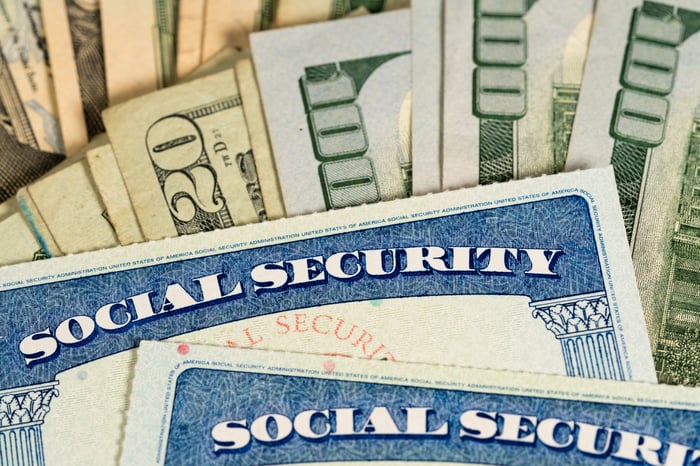Social Security is unequivocally the nation's most important social program. Each month, over 62 million Americans take home a benefit check, of which 62% of aged beneficiaries lean on to comprise at least half of their income. Without Social Security, retired workers, the elderly, and even the surviving spouses and/or children of deceased workers could see considerably higher rates of poverty.
But for as much as Social Security has done over a nearly eight-decade period, it hasn't kept the program from running into trouble. A number of ongoing demographic changes, compounded with inaction from Congress, is sending Social Security down a tumultuous path. In fact, fear regarding Social Security's long-term outlook has become so apparent that a Pew Research Center survey in 2014 found that 51% of millennials didn't expect the program to be there when they eventually retire.

Image source: Getty Images.
Social Security has problems, but running out of cash isn't one of them
The big question a lot of folks (especially millennials) are probably asking about Social Security, given its many problems, is this: When, exactly, will the program run out of cash?
Believe it or not, the honest answer, assuming no changes to the way Social Security is funded, is never.
Without question, Social Security has its problems. The worker-to-beneficiary ratio is expected to decline until 2035 as baby boomers leave the workforce and become eligible for a retirement benefit. There simply aren't enough new workers to step in for these retiring boomers to buoy the worker-to-beneficiary ratio.
Retirees are also living substantially longer than they were, say, five or six decades ago. The average life expectancy has increased by nine years since 1960, and the percentage of Americans making it to the eligible initial claiming age of 62 has risen substantially, too.
Even income inequality has reared its head and hurt Social Security. We're witnessing a greater percentage of earned income being exempted from Social Security's payroll tax -- $300 billion in 1983 versus $1.2 trillion in 2016 -- while also seeing the well-to-do live significantly longer than lower-income folks whom the system was designed to protect. Ultimately, it means a lot of Social Security income is winding up in the hands of the wealthy.

Image source: Getty Images.
Social Security's excess cash could soon disappear...
But the biggest concern of all is the inflection point the program has hit. According to the newest annual Trustees report, Social Security will expend more than it collects in revenue this year for the first time since 1982. Though the amount of estimated net cash outflow ($1.7 billion) is relatively small next to the $2.89 trillion currently held in asset reserves, this outflow is expected to increase rapidly beginning in 2020 and beyond.
Where the misconception that Social Security is running out of cash comes into play is based on the Trustees' latest prediction that the program's asset reserves will be exhausted by 2034. Should this excess cash run out as forecast, an across-the-board cut to benefits of up to 21% may be needed to sustain payouts through 2092, without the need for any further cuts.
So, to be clear, Social Security's excess cash may very well be depleted in less than two decades. But this isn't the same as saying, "Social Security will run out of cash." Even if the program doesn't have a red cent in excess cash, it can still continue divvying out a benefit check to eligible recipients, thanks to its two sources of recurring revenue.

Image source: Getty Images.
... but its recurring sources of revenue ensure it'll never run out of cash
Currently, Social Security has three sources of funding. Assuming Congress fails to act and the Trust's asset reserves are indeed depleted, then one of those sources -- the interest income earned on its excess cash -- will go away. Still, it leaves two sources of recurring revenue that ensure payouts can continue.
The first is Social Security's payroll tax, a 12.4% tax on earned income between $0.01 and $128,400, as of 2018. As long as Americans keep working and Congress doesn't remove the payroll tax as a source of revenue, the payroll tax will remain the program's heavy hitter, so to speak. In 2017, the payroll tax generated $873.6 billion of the $996.6 billion collected.
The second recurring source of revenue is the taxation of benefits. Signed into law in 1983 and implemented in 1984, the taxation of benefits allows recipients earning above certain thresholds -- adjusted gross income plus one-half benefits above $25,000 for individuals and $32,000 for couples filing jointly -- to have a portion of their Social Security benefits taxed at federal ordinary income-tax rates. In 2017, the taxation of benefits led to $37.9 billion being collected.
As long as these two sources of revenue remain intact, there will always be money for the Social Security Administration to disburse to eligible beneficiaries. The program simply can't run out of cash... ever. This doesn't mean payouts aren't subject to potential reductions over time -- but it does suggest that Social Security won't go bankrupt.




